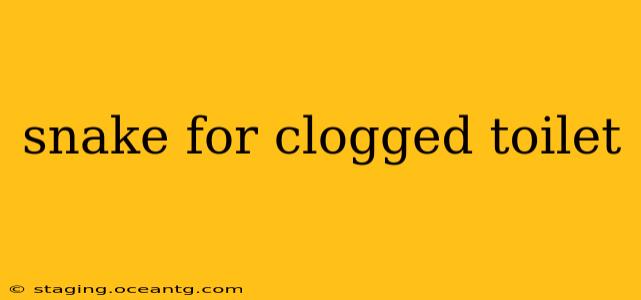A clogged toilet is a frustrating plumbing problem, but thankfully, often solvable with a simple tool: a toilet snake. This comprehensive guide will walk you through everything you need to know about using a snake for a clogged toilet, helping you conquer that plumbing emergency quickly and effectively.
What is a Toilet Snake?
A toilet snake, also known as a drain snake or auger, is a flexible metal cable with a coiled end. This design allows it to navigate the bends and curves of your toilet's drainpipe, reaching the clog and breaking it up or retrieving the obstruction. They come in various lengths and diameters, making them suitable for different types of clogs and drain systems.
How to Use a Toilet Snake for a Clogged Toilet
Before you begin, always ensure the toilet water level is as low as possible. This minimizes the mess and makes the process easier.
-
Insert the Snake: Carefully insert the snake into the toilet drain opening. Gently rotate the handle as you push the snake deeper into the drain. Feel for resistance; this indicates you've reached the clog.
-
Break Up the Clog: Once you feel resistance, continue rotating the handle and gently push the snake further into the clog. The rotating action helps break up the blockage. You might feel the resistance lessen as the clog breaks up.
-
Retrieve the Obstruction (If Possible): If the clog is a solid object, you may be able to hook it and retrieve it using the snake.
-
Flush and Check: Once you feel the snake is clear, slowly remove it from the drain. Flush the toilet to check if the clog is cleared. If the water drains normally, you're done!
-
Repeat if Necessary: If the toilet is still clogged, repeat steps 1-4. You might need to use a different technique or try using a different part of the snake to ensure effective clearing.
What Causes a Clogged Toilet?
Understanding the root cause can prevent future clogs. Common culprits include:
- Too Much Toilet Paper: Using excessive amounts or the wrong type of toilet paper is a frequent offender.
- Flushable Wipes: Despite their marketing, many "flushable" wipes do not fully break down and cause clogs.
- Foreign Objects: Toys, feminine hygiene products, and other items accidentally dropped in the toilet are common culprits.
- Sewage Backup: In severe cases, a clog might stem from a broader sewage issue in your plumbing system. This requires professional intervention.
What if my toilet is still clogged after using a snake?
If you've tried using a toilet snake and the toilet remains clogged, it's time to call a professional plumber. A more serious plumbing issue might be at play, and a plumber possesses the tools and expertise to diagnose and resolve the problem effectively. Ignoring a persistent clog can lead to further damage and more expensive repairs.
What type of toilet snake should I buy?
Toilet snakes are available in various lengths and designs. A shorter snake (around 18-24 inches) will suffice for most household clogs. For more stubborn clogs or if you suspect the blockage is further down the drain, a longer snake might be necessary.
Can I use a regular drain snake on a toilet?
While you can use a standard drain snake on a toilet, it’s generally not recommended. Toilet snakes are designed with a more compact head, better suited for the delicate curves of a toilet drain. Using a larger drain snake could cause damage to your toilet's internal components.
How often should I use a toilet snake?
Regular use of a toilet snake is unnecessary unless you're experiencing recurring clogs. However, following proper toilet usage guidelines (limiting toilet paper, avoiding flushing inappropriate items) can help prevent clogs entirely.
This guide offers a practical approach to resolving clogged toilets with a toilet snake. Remember, prevention is key; mindful toilet usage is your best bet in avoiding future plumbing emergencies! If you are dealing with a persistent or severe clog, contacting a professional plumber is always the recommended course of action.
